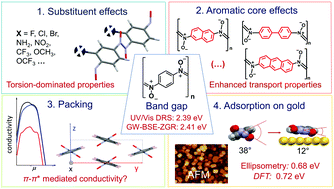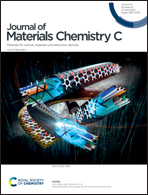Modulating electronic properties of dinitrosoarene polymers†
Abstract
Using the dinitrosobenzene polymer (1) as a model, we explore how the electronic, transport, and optical properties of a conjugated organic semiconductor can be modulated. Combining computational and experimental tools, we explore the effects of solid-state packing, backbone torsion, surface adsorption, the conjugation in the aromatic core, and substituents. The band gap (Eg) and optical spectrum of 1 are calculated using both GW-BSE with zero-gap renormalization (ZGR) and hybrid TD-DFT, with the former method predicting a value (2.41 eV) in excellent agreement with our diffuse reflectance spectroscopy measurements (2.39 eV). Using GW-BSE-ZGR, changes occurring upon solid-state packing are separated into a contribution arising from (i) the change in the torsional angle and (ii) the change in the screened Coulombic interaction, which strongly affects the exciton binding energies. Comprehensive hybrid TD-DFT calculations find that the effects of substituents on Eg and on transport properties can mostly be explained through changes in the torsional angle θ, and predict a linear dependence between θ and Eg. Extending the conjugation in the aromatic core is found to enhance transport properties and narrow Eg, identifying future synthetic targets. Atomic force microscopy and spectroscopic ellipsometry are used to study 1 adsorbed to a (111) gold surface (1@Au), with the latter method showing a significant narrowing of the band gap to 0.68 eV, in good agreement with TD-DFT predictions.



 Please wait while we load your content...
Please wait while we load your content...